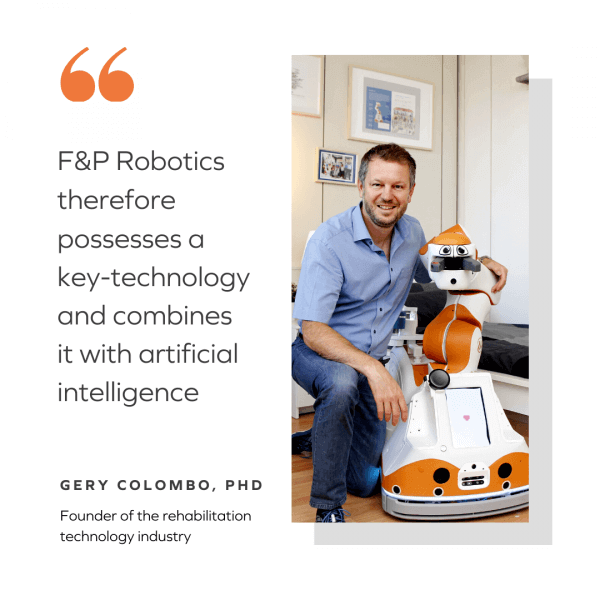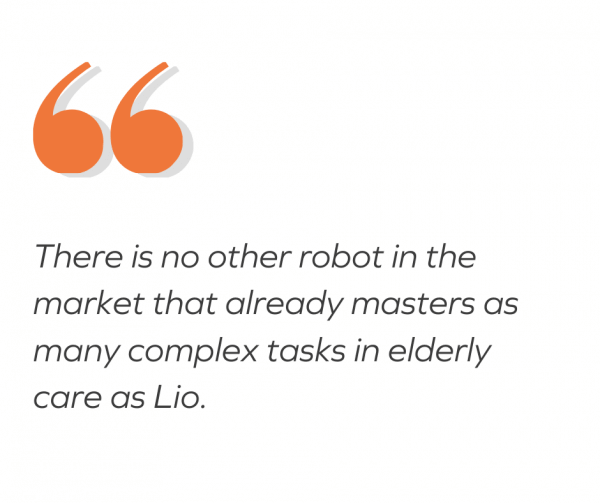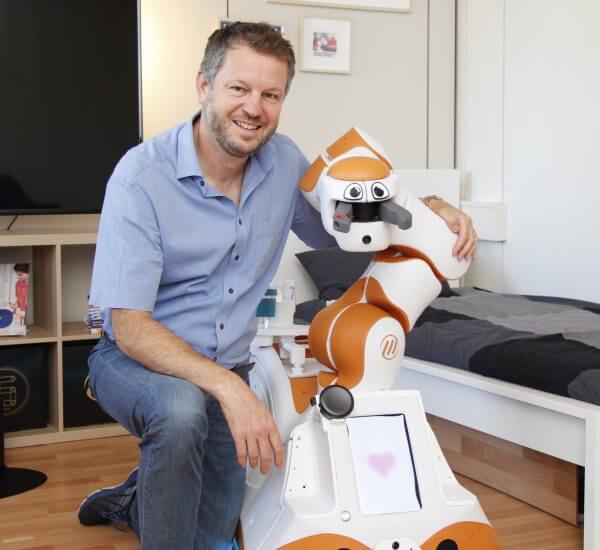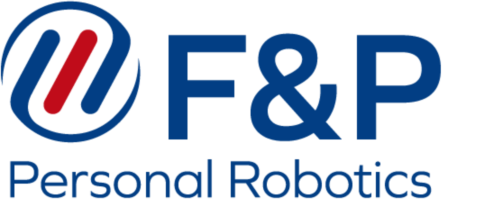The Tech-Firm F&P Robotics has pulled off a coup: Their latest addition to the advisory board is Gery Colombo, a true pioneer in Robotics. Once he revolutionised the rehabilitation in the health industry, now he explains why and how F&P Robotics can achieve the same in elderly care.
Gery Colombo, do you still remember your first contact with F&P Robotics?
My history with F&P Robotics goes way back and starts with the “F”. The founder of the firm: Hansruedi Früh and I have worked together in the 90s when we both worked together in research – this included projects of the national science foundation. We have stayed in contact ever since, also after the establishment of F&P Robotics in 2014. Hence I was always aware of what was going on. A year ago I was visiting F&P Robotics with representatives of Vamed from the rehabilitation clinic in Zihlschlacht. Vamed is a client of my previous firm, Hocoma. Today, they are also one of the first and most important customers of Lio, the care-robot of F&P Robotics.
Where do you see the similarities between F&P Robotics and your former company, Hocoma?
With the inception of Hocoma in 2000, we have started a revolution in rehabilitation therapy. Because we were able to introduce the first commercially available robot into the field, the Lokomat, and thereby support patients in their pursuit to regain the ability to walk. That was pioneering. Nowadays, F&P Robotics is at a similar point, they are also pioneers in elderly care. Their care-robot Lio is the first of its kind.
More about Lio

But in elderly care, the revolution has only begun. How do you assess the chances of F&P Robotics to accomplish the same as Hocoma?
Generally speaking, robotics will play a significant role in all the parts of the economy that require manual labor. And this is the case in health care. Within health care, F&P Robotics has positioned itself in the segment of elderly care, and here the demand for an innovative solution like Lio is particularly high. Nursing homes and hospitals are already under enormous pressure to find sufficient staff. This shortage of skills will accentuate in the future. Due to demographics, there will be more and more elderly people to take care of – at the same time, the number of laborers in health care is limited. Furthermore, the situation with Covid19 poses additional and new challenges to elderly care and the people working in it. For example, care specialists need to look after the patients while maintaining distance. All that increases the requirement for technological support exponentially. Hence I am convinced that robotics will become a crucial part of elderly care. The only remaining question is when this will happen.
And what do you think will determine the answer?
Different aspects. First of all, the robots need to be able to fulfill the tasks that caregivers and patients require them to do. That’s a technological challenge. A robot in the 90s was mainly good for clearly defined and repetitive tasks that needed to be executed quickly. For example, a gripper arm that assembles cars. The requirements in elderly care are completely different. Here you find tasks that cannot be clearly specified. There is little routine, but a lot of diverse and complex challenges that change from day to day. The strongest asset of Lio is that he already masters many of the required skills. F&P Robotics, therefore, possesses a key-technology and combines it with artificial intelligence. Here, the company profits tremendously from the yearlong experience of founder Hansruedi Früh. However, there is another challenge.
What challenge?
New technologies face problems of acceptance, I have been confronted with that heavily in my previous firm Hocoma. At that time, not only did we have to come up with a technologically sophisticated solution, but we also needed to convince the physiotherapist that said technology is for their own benefit. The initial reaction of the physiotherapists was averse, they feared that these new robots are not here to help, but replace them. Understandably, they made a stance against that.

How have you dealt with these fears?
It’s about the right communication, which is absolutely paramount. And it needs to be right from the beginning. You cannot go to a clinic, only talk to the administrators and explain to them: “This robot helps you cut costs since you won’t need as many employees anymore.” You need to immediately get the specialist staff on board as well. And you need to make it clear that these robots support them and thereby increase effectiveness and efficiency. The robots are meant to lighten the workload of specialists so that they can focus on other priorities. The robots can deal with the tasks that caregivers dislike, for example physically straining activities. Basically, it is like this: If you ask people who work in health care whether they need support, they will always answer yes, as most of them have too much on their plate and suffer under the constant hassle of too few resources. So the next question ought to be: Where can Lio assist you, what do you need him to be capable of. This feedback loop is then also very valuable for research and development, as ultimately, this is what the robot has to effectively deliver.
More about Research and Development
So interpersonal competencies remain key even with robotisation?
Absolutely. It is also a two-sided market. The robots support the caregivers on one side and the patients on the other. So the patients also have to accept the robots. Therefore, communication is also crucial in this respect. If you can show to elderly people that a robot assists a caregiver so that this person has more time available to interact socially with the patient, they will have a greater appreciation for the value of the technology.
Does that mean, that to prevail in the market, F&P Robotics will not only have to offer high-quality robots but also first-class services to complement them?
I think this is crucial in the early stage of the market. By educating and offering introductory courses, we have to convince all concerned parties of the added value by getting the right messages through. But we also have to convey proper handling. A robot is not a blender that you can put into the kitchen and everyone understands what to do next. Furthermore, the utilisation of these new technologies is not yet part of the curricula for health care professionals.
Chances are enormous, but the challenges are also considerable. In this context, what role do you play as the chairman of the subcommittee for care robotics in the advisory board of F&P Robotics?
I provide a lot of experience in how to tap new markets as a pioneer. Furthermore, I also founded a scientific advisory board for Hocoma. So I know how to set up such an institution to contribute a direct added value to the company. The main objective of an advisory board has to be to holistically identify customer needs. That’s pretty much what you can read in every management school textbook, but what it means for your daily business is a different story.
And how can an advisory board unravel that story?
You need the right people in your advisory board, people that truly know and represent your customers’ needs. They should be opinion and thought leaders. And they should think ahead. They should be able to anticipate. Not just recycle yesterday’s needs, but foresee tomorrow’s opportunities. If you have those experts, you can prepare recommendations for the executive board of a company as to how they can advance their products and the organisation to become more competitive. That’s my aspiration as a board member. I am not just a name on a sheet of paper for PR reasons and that was it. I want to have a real impact.
As an advisor what do you expect from F&P Robotics?
Being a pioneer, F&P Robotics is leading the market with Lio in its segment. But big challenges will come once the market further develops and once the company will continue to internationalise. F&P Robotics already has a footprint in German-speaking Europe, it has sold robots there. But the most interesting market in health care is the US, and a prospective growth market is China. I want F&P Robotics to be not just a pioneer in these markets, but also the dominant leader in the years to come.
How positive are you that F&P Robotics will remain market leader?
Obviously very much, as there is no other robot in the market that already masters as many complex tasks in elderly care as Lio. And you need to take into consideration: These tasks change from market to market. A grandmother in Shenzhen has different needs than a grandfather from Wisconsin, starting with the language. And due to the interplay of cloud computing and artificial intelligence, Lio is extremely potent in interconnected learning, which makes him very versatile and flexible. If one robot in one location acquires a new skill, it can be immediately adapted by every other Lio in the market. Lio will be capable of more and more tasks simply as time progresses, and he will therefore be even more tailored to customers’ preferences. This renders him unbeatable.
Apart from Lio, F&P Robotics provides robots to other segments as well, for example with Bar-Robot Barney in catering. What’s your stance on this strategic diversification?
I am an expert in care robotics, this is where I want to have an impact. I can’t speak much for the other segments. Clearly, the potential of the key technology behind F&P Robotics in other fields is also significant, even if those markets need to be tapped individually. Therefore, I think it is important that the advisory board comprises different committees with different people, and that these committees tackle the distinct markets like industry, care, and gastronomy separately. This will prevent that the company loses focus and guarantee that it can specifically target the opportunities of each market.
More about Care Robotics
About Gery Colombo, PhD


